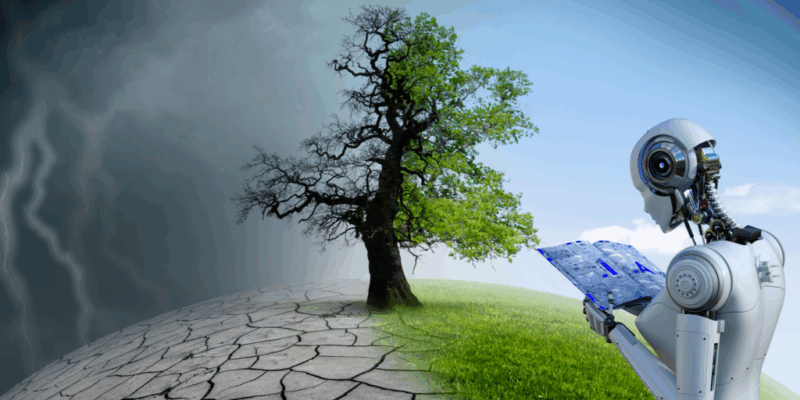
Climate change is one of the most urgent challenges of our time. From rising temperatures and extreme weather events to biodiversity loss and food insecurity, the consequences are widespread and deeply interconnected. As the world seeks bold, innovative strategies to mitigate and adapt to climate change, Artificial Intelligence (AI) is emerging as a powerful ally.
AI’s ability to analyze vast datasets, predict trends, optimize systems, and even automate complex processes is unlocking new pathways for fighting climate change faster and more effectively. Let’s explore how AI is becoming an indispensable tool in the global climate action toolkit.
How AI is Revolutionizing Climate Solutions
1. Predictive Climate Modeling
Traditional climate models take years to run complex simulations. AI can process massive datasets and model climate scenarios more quickly and accurately. Machine learning algorithms help scientists better predict weather patterns, sea-level rise, and ecosystem changes.
Impact: Faster and more detailed insights for policymakers and researchers.
2. Optimizing Renewable Energy Systems
AI improves the efficiency of solar, wind, and hydropower systems by predicting energy production, optimizing grid management, and reducing waste. Companies use AI to forecast solar irradiation, wind speeds, and energy demand, balancing supply with real-time needs.
Impact: Smarter, more resilient renewable energy grids.
3. Carbon Capture and Storage (CCS)
AI is enhancing the effectiveness of carbon capture technologies by modeling where CO₂ storage is most viable and improving monitoring systems that detect leaks.
Impact: Safer, more efficient carbon removal strategies.
4. Smart Agriculture
AI-driven precision agriculture uses drones, sensors, and predictive analytics to help farmers optimize irrigation, reduce pesticide use, and enhance crop yields—all while minimizing environmental impact.
Impact: More sustainable food systems and reduced emissions from agriculture.
5. Forest Monitoring and Reforestation
AI systems, combined with satellite imagery, are tracking deforestation in real-time, identifying illegal logging activities, and helping guide reforestation efforts by selecting the best planting sites and times.
Impact: Protecting and restoring vital carbon sinks.
6. Disaster Response and Climate Adaptation
AI models can predict natural disasters like floods, wildfires, and hurricanes more accurately, allowing communities to prepare and respond faster. Early warning systems powered by AI save lives and reduce economic losses.
Impact: Building more resilient communities in a warming world.
Real-World Examples of AI in Action
Climate TRACE
An initiative co-founded by former U.S. Vice President Al Gore, Climate TRACE uses AI and satellite data to independently track greenhouse gas emissions across the globe in near real-time.
DeepMind’s Wind Energy Project
Google’s DeepMind developed an AI model that increased the value of wind energy by 20% by predicting wind output 36 hours in advance, making wind power more reliable.
PlantVillage Nuru
This AI-powered app helps African farmers diagnose crop diseases using smartphone images, supporting healthier harvests and reducing food insecurity.
Challenges and Considerations
While AI offers incredible promise, it’s not without challenges:
-
Energy Consumption: Training large AI models can consume significant energy, potentially contributing to emissions.
-
Data Gaps: In some regions, especially in the Global South, limited access to high-quality environmental data can hinder AI’s effectiveness.
-
Ethical Risks: Biased algorithms or opaque decision-making could lead to unintended consequences.
-
Accessibility: Advanced AI solutions may remain out of reach for poorer communities unless consciously designed for inclusivity.
Responsible AI development—focusing on transparency, fairness, and sustainability—is essential to ensure that its benefits are equitably distributed.
The Future: AI as a Climate Champion
Looking ahead, the potential for AI to drive climate action is immense. Future developments may include:
-
AI-optimized carbon markets that ensure transparency and real impact.
-
Autonomous climate monitoring drones surveying remote ecosystems.
-
Hyperlocal climate adaptation models personalized for individual communities.
-
New materials discovery for carbon-negative products and renewable energy storage.
With thoughtful deployment and global collaboration, AI can become a cornerstone of humanity’s fight against climate change, helping to build a more sustainable, resilient, and equitable world.
Conclusion: Intelligence for a Cooler Planet
Climate change demands solutions that are fast, scalable, and innovative—and Artificial Intelligence is answering the call.
From predicting extreme weather events to optimizing energy use and protecting forests, AI is empowering humanity to act smarter and faster. But with great power comes great responsibility. Ensuring that AI is developed and used ethically and sustainably is key to unlocking its full potential in the race against climate change.
The future is clear: by merging human ingenuity with machine intelligence, we can chart a more hopeful path for our planet.
Read more on Tech Gist Africa:
Sustainable Innovation in Africa: How Tech is Addressing the Continent’s Energy Crisis
Innovation Hubs Around the World: How Cities are Becoming Global Tech Powerhouses
The Role of CleanTech in the Fight Against Global Air Pollution










Comments